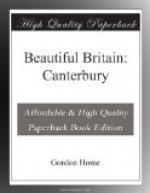[Illustration: The Greyfriars’ house in Canterbury. This picturesque house of the Franciscans, who came to the town in 1220, stands on a branch of the Stour near Stour Street.]
The porch belongs to the great period of rebuilding under Prior Chillenden, and, with its double row of canopied niches containing statues, is a beautiful feature, even with the central space which contained a representation of the martyrdom of Becket still vacant since the days of Henry VIII. There is in the first view of a vast Cathedral nave something almost overpowering in its sense of ordered beauty. It may be that average lives are so planless, so haphazard and without order that an achievement of such magnitude representing years of labour and concentrated thought in steadily following out a preconceived plan cannot fail to be a tremendous contrast to the smallness and pettiness of the majority—a contrast so great that it is mentally and spiritually a glimpse of the world of new possibilities attainable when once the feverish clinging to the ideals of the totem post is abandoned. This vast nave, reminiscent in many ways of Winchester, but far more satisfying, is generally bathed in a cool, greenish light, and is, in reality, a magnificent vestibule to the crowded interest beyond the transept. The effect of emptiness existing to-day is vastly different to what the pilgrims used to gaze upon while waiting their turn to be sprinkled with holy water, for before the Reformation and the complete sweeping away of the enrichments of Roman Catholic times the roof and walls were brilliant with paintings, the windows glowed with the warm colour of medieval glass, sumptuous hangings were suspended in many places and the altars twinkling with lighted candles added much gilding and colour to the aisles. All this barbarous crowding of colour and ornament, all this splendour of a ritual that appealed to an age capable of stilling the voice of conscience with an absolution obtainable for a few pence has passed away, but the vast building remains to tell of the reality of endeavour of one side of monastic life.
[Illustration: The picturesque gabled
houses of the Canterbury
Weavers.
The houses are reflected in the Stour just by King’s
Bridge, which joins the High Street to St. Peter’s
Street.]
Across the great arch opening into the base of the tower is the supporting arch inserted by Prior Goldstone II., who, as already stated, built the Angel Steeple above the roof-line where it had been left by Chillenden. The arch has been called a disfigurement, and as it was not originally intended such an opinion may be justifiable, and yet the beauty of the reticulated stonework and the consummate skill which conceived the bold simplicity of design is so satisfying that it is scarcely possible to wish that it were absent. Beneath this flying arch appears the splendid western




